Articles and Features
Who made the biggest splash in the art world in 2018?
Art is not only about the artworks. Art is also about the people and the moments in between – the controversies, the collectors and the random events that make you contemplate if it’s even possible to separate art from everyday life. We’ve compiled a list of some of the most important works and moments that made up the art world in 2018.
Most expensive artwork
Portrait of an Artist (Pool with Two Figures) – David Hockney
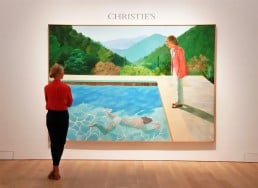
No artist made a bigger splash in the commercial realm of art in 2018 than David Hockney. The 81 year old pop artist became the most expensive living artist in November when Portrait of an Artist (Pool with Two Figures) sold at Christie’s for $80 million at the hammer, or $90.3 million with fees. The record-breaking sale surpassed Jeff Koons’ 2013 record of $58.4 million USD. “David Hockney’s brilliance as an artist is on full display with this monumental canvas, which encapsulates the essence of the idealized poolside landscape, and the tremendous complexity that exists within human relationships,” said Alex Rotter, co-chairman of postwar and contemporary art at Christie’s. “With this painting, Hockney cemented his placement within the realm of history’s most venerated artists.” Hockney made the painting back in 1972 and is heralded as the most valuable one of all of his pool-related pieces.
Best art imitating life
America – Maurizio Cattelan and Nancy Spector
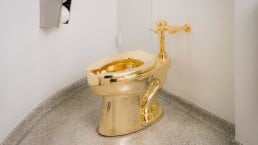
In 2017 First Lady Melania Trump and the Office of the Curator of the presidential mansion asked the Guggenheim if they could borrow the museum’s Vincent van Gogh’s 1888 Landscape With Snow. In January 2018 museum deputy Nancy Spector at the Guggenheim politely declined, but offered to lend them America by Maurizio Cattelan instead – a fully functional golden toilet. One-hundred-and-one years after Duchamp’s urinal, Spector and Cattelan have reversed Duchamp, transforming the meaning of a work of art, suggesting that this formerly very public sculpture can have a new life as a very site-specific work in the private residence of the Trump White House. Here America would be used as a working toilet while also becoming an emblematic symbol of Trump’s love of gold and gaudiness. An artwork made out of the most precious of metals meant for man’s most mundane and primitive routine. That’s not only art imitating life, that’s art literally facilitating it.
Best life imitating art
Live Tinder – Natasha Aponte
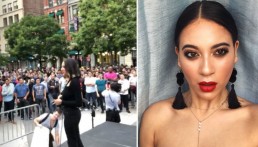
In August Natasha Aponte used Tinder to invite several dozen guys on a simultaneous date in New York City, supposedly to cast light on gender, technology issues, and the absurdity of modern app dating, of course leaving her targets totally bewildered. The date turned out to be an event that the host described as “Live Tinder,” a real-life game show of sorts that resembled a cross between The Bachelorette, Hunger Games and Catfish. After Natasha informed the group of men that they could compete for a date with her, she started sending them away. Trump supporters were sent away. Men named “Jimmy” were sent away. Men who smoked or drank heavily were sent away. Men under 5’10” were sent away. By the time the physical challenges started, it looked like only about two dozen guys were left. The stunt has since been rumoured to be part of a viral marketing stunt. We don´t know for whom yet. The Marina Abramovic of the millennial generation or the Michael Jordan of catfishing?
Most controversial artwork
Love is in the bin – Banksy
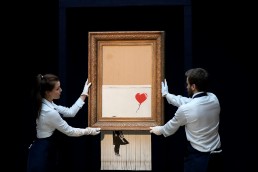
It might be controversial in itself to claim that Banky’s self destructing painting at Sotheby’s in October is actually 2018’s most controversial work of art. But the stunt at the famous auction house in October most definitely made a big stir on the art scene and in social media. The final lot of the sale — Banksy’s Girl with Balloon — was in the midst of an intense bidding battle from buyers in the room and on the phones. Seconds after the hammer fell, however, part of the canvas passed through a hidden shredder, and in the process of ‘destroying’ the artwork, a new one was created. The new work has been granted a certificate by Pest Control, Banksy’s authentication body, and has been given a new title, Love is in the Bin. The buyer commented: “When the hammer came down last week and the work was shredded, I was at first shocked, but gradually I began to realise that I would end up with my own piece of art history.” The artist defended the shredding with a quote from Picasso: “The urge to destroy is also a creative urge.”
Biggest art controversy
We are not surprised
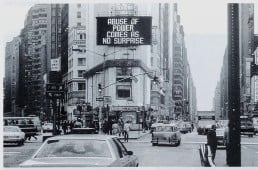
The #metoo of the art world actually started in 2017, in the wake of numerous sexual harassment allegations against longtime Artforum co-publisher Knight Landesman. But the movement and protests lasted well into 2018. After Knight Landesman resigned as co-publisher of Artforum in late 2017, thousands of women in the art world, including Barbara Kruger and Cindy Sherman, signed an open letter posted to the website of a new feminist group called We Are Not Surprised, inspired by Jenny Holzer’s iconic work Abuse of Power Comes as No Surprise. The letter condemned art institutions that claimed the rhetoric of feminism and equity in theory while preserving oppressive and harmful sexist norms in practice: “We are not surprised when curators offer exhibitions or support in exchange for sexual favors. We are not surprised when gallerists romanticize, minimize, and hide sexually abusive behavior by artists they represent. We are not surprised when a meeting with a collector or a potential patron becomes a sexual proposition. We are not surprised when we are retaliated against for not complying. We are not surprised when Knight Landesman gropes us in the art fair booth while promising he’ll help us with our career. Abuse of power comes as no surprise.”
Most instagrammed artwork(s)
The Obama portraits – Kehinde Wiley and Amy Sherald
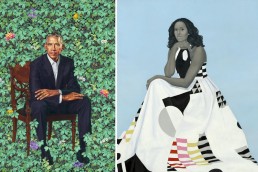
The Obama portraits were all over Instagram this year, and with good reason. To execute the commissions of the official Obama portraits is an almost impossible task. But both of these artists rose to the occasion and delivered big. The president’s portrait is by Kehinde Wiley, a big star on the art scene. Explaining his choice of Wiley, the former president said, “What I was always struck by when I saw his portraits was the degree to which they challenged our ideas of power and privilege.” Wiley depicts African blue lilies, jasmine, and chrysanthemums to represent and map Obama’s journey from Kenyan roots, to Hawaii, to the official flower of Chicago. The portrait of Michelle Obama is by Amy Sherald. At the unveiling, the president noted that Sherald’s portrait of the First Lady captures “the grace and beauty and intelligence and charm and hotness of the woman that I love.” And as The First Lady said at the unveiling, Sherald’s work will have impact on girls of color: “They will see an image of someone who looks like them hanging on the wall of this great American institution. I know the kind of impact that will have on their lives because I was one of those girls”.
Most memorable exhibition
Paintings for the future – Hilma af Klint, The Guggenheim-New York
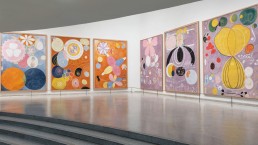
When Hilma af Klint began creating radically abstract paintings in 1906, they were like little that had been seen before: bold, colorful, and untethered from any recognizable references to the physical world. It was years before Vasily Kandinsky, Kazimir Malevich, Piet Mondrian, would take similar strides to rid their own artwork of representational content. Yet while many of her better-known male contemporaries published manifestos and exhibited widely, af Klint kept her groundbreaking paintings largely private. She rarely exhibited them and, convinced the world was not yet ready to understand her work, stipulated that it not be shown for twenty years following her death. Ultimately, her work was all but unseen until 1986, and only over the subsequent three decades have her paintings and works on paper begun to receive serious attention. Like art critic Jerry Saltz so precisely put it, “Klint created her own optical language with visual, chromatic, structural, and narrative syntax. Her artistic ship sails some of the deepest waters around.”
Most influential collector
Stefan Edlis
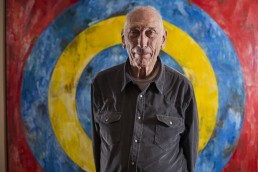
There’s a bunch of big and influential collectors around the world. But not all of them star in one of 2018’s greatest documentary films. Stefan Edlis is not only a star in the world of art collectors, he also plays a big role in the greatly researched and produced documentary The Price of Everything. Love him or hate him, the plastic industry magnate pulls no punches when it comes to collecting art. Edlis started collecting art in the late 1970s, initially buying only artworks made of plastic, and then switching to postwar and Pop art. In April 2015, Edlis and his wife, Gael Neeson, donated 42 works of Pop and contemporary art, together worth $500 million, to the Art Institute of Chicago. Their collection includes pieces by Jasper Johns, Roy Lichtenstein, Cy Twombly, and Andy Warhol, as well as works by more contemporary artists like Maurizio Cattelan, Katharina Frisch, and Ugo Rondinone.
Best crossover collaboration
Utopian Fantasy – Ignasi Monreal and Gucci

Like if René Magritte and Rihanna had a baby. That’s what immediately comes to mind when you see Gucci´s Spring/Summer 2018 collection campaign for the first time – a campaign that was entirely painting-based. Utopian Fantasy, launched in January, took the form of printed ads, online content, and large-scale painted murals in locations including New York and Milan. Utopian Fantasy featured over 70 hand-drawn visuals, all created by Spanish artist Ignasi Monreal, which take inspiration from fairytales, greek mythology, and Renaissance painters, but with a modern Gucci twist. From mermaids scrolling through social feeds to tiger-human hybrids wearing Gucci sunglasses, each photorealist piece is an invitation to enter a world filled with the uncanny, the sublime and lots of glittery details.
Best dressed artist
Yayoi Kusama

“One day I was looking at the red flower patterns of the tablecloth on a table, and when I looked up I saw the same pattern covering the ceiling, the windows and the walls, and finally all over the room, my body and the universe. I felt as if I had begun to self-obliterate, to revolve in the infinity of endless time and the absoluteness of space.” The 89 year old eccentric Japanese artist refers to her famous spots as the overwhelming and lifesaving power in her life. Without her art, she claims, she would have committed suicide a long time ago. That’s not your usual pseudo-artistic flim-flam coming from a person that has spent the last 37 years at a mental hospital. From there she creates art, while maintaining a studio near the hospital for her large scale installations, some of which have been shown at solo exhibitions all over the world in 2018. Unmissable in her neon red wigs and polka-dotted outfits the fashion obsessed artist is the embodiment of her artistic style.